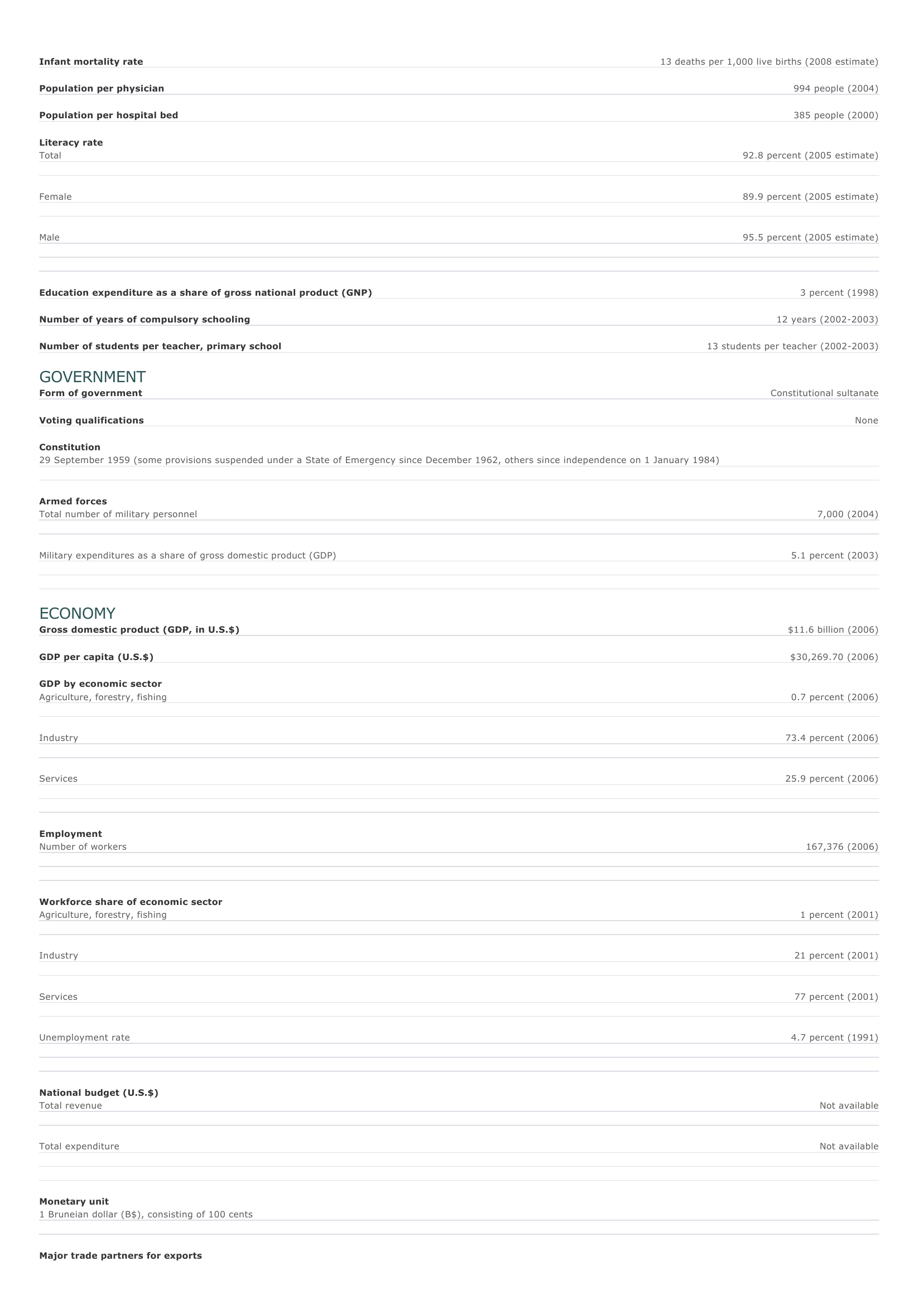
Brunei Facts and Figures. BASIC FACTS Official name Capital Area Negara Brunei Darussalam Bandar Seri Begawan 5,765 sq km 2,226 sq mi PEOPLE Population 381,371 (2008 estimate) Population growth Population growth rate 1.78 percent (2008 estimate) Projected population in 2025 498,756 (2025 estimate) Projected population in 2050 638,157 (2050 estimate) Population density 72 persons per sq km (2008 estimate) 188 persons per sq mi (2008 estimate) Urban/rural distribution Share urban 78 percent (2005 estimate) Share rural 22 percent (2005 estimate) Largest cities, with population Bandar Seri Begawan 61,000 (2003 estimate) Ethnic groups Malay 64 percent Chinese 20 percent O ther 16 percent Languages Malay (official), English, Chinese Religious affiliations Muslim (Islam is the official religion) 64 percent Indigenous beliefs 11 percent Buddhist 9 percent Christian 8 percent O ther 8 percent HEALTH AND EDUCATION Life expectancy Total 75.5 years (2008 estimate) Female 77.8 years (2008 estimate) Male 73.3 years (2008 estimate) Infant mortality rate 13 deaths per 1,000 live births (2008 estimate) Population per physician 994 people (2004) Population per hospital bed 385 people (2000) Literacy rate Total 92.8 percent (2005 estimate) Female 89.9 percent (2005 estimate) Male 95.5 percent (2005 estimate) Education expenditure as a share of gross national product (GNP) 3 percent (1998) Number of years of compulsory schooling Number of students per teacher, primary school 12 years (2002-2003) 13 students per teacher (2002-2003) GOVERNMENT Form of government Constitutional sultanate Voting qualifications None Constitution 29 September 1959 (some provisions suspended under a State of Emergency since December 1962, others since independence on 1 January 1984) Armed forces Total number of military personnel Military expenditures as a share of gross domestic product (GDP) 7,000 (2004) 5.1 percent (2003) ECONOMY Gross domestic product (GDP, in U.S.$) $11.6 billion (2006) GDP per capita (U.S.$) $30,269.70 (2006) GDP by economic sector Agriculture, forestry, fishing 0.7 percent (2006) I ndustry 73.4 percent (2006) Services 25.9 percent (2006) Employment Number of workers Workforce share of economic sector Agriculture, forestry, fishing 167,376 (2006) 1 percent (2001) I ndustry 21 percent (2001) Services 77 percent (2001) Unemployment rate 4.7 percent (1991) National budget (U.S.$) Total revenue Not available Total expenditure Not available Monetary unit 1 Bruneian dollar (B$), consisting of 100 cents Major trade partners for exports Japan, South Korea, Thailand, Australia, United States Major trade partners for imports Singapore, Japan, Malaysia, United Kingdom, Hong Kong SAR ENERGY, COMMUNICATIONS, AND TRANSPORTATION Electricity production Electricity from thermal sources 100 percent (2003 estimate) Electricity from hydroelectric sources 0 percent (2003 estimate) Electricity from nuclear sources 0 percent (2003 estimate) Electricity from geothermal, solar, and wind sources 0 percent (2003 estimate) Number of radios per 1,000 people 302 (1997) Number of telephones per 1,000 people 224 (2005) Number of televisions per 1,000 people 635 (2000 estimate) Number of Internet hosts per 10,000 people Daily newspaper circulation per 1,000 people Number of motor vehicles per 1,000 people Paved road as a share of total roads 177 (2003) 69 (1996) 438 (2003) 78 percent (2005) SOURCES Basic Facts and People sections Area data are from the statistical bureaus of individual countries. Population, population growth rate, and population projections are from the United States Census Bureau, International Programs Center, International Data Base (IDB) (www.census.gov). Urban and rural population data are from the Food and Agriculture Organization (FAO) of the United Nations (UN), FAOSTAT database (www.fao.org). Largest cities population data and political divisions data are from the statistical bureaus of individual countries. Ethnic divisions and religion data are largely from the latest Central Intelligence Agency (CIA) World Factbook and from various country censuses and reports. Language data are largely from the Ethnologue, Languages of the World, Summer Institute of Linguistics International (www.sil.org). Health and Education section Life expectancy and infant mortality data are from the United States Census Bureau, International Programs Center, International database (IDB) (www.census.gov). Population per physician and population per hospital bed data are from the World Health Organization (WHO) (www.who.int). Education data are from the United Nations Educational, Scientific and Cultural Organization (UNESCO) database (www.unesco.org). Government section Government, independence, legislature, constitution, highest court, and voting qualifications data are largely from various government Web sites, the latest Europa World Yearbook, and the latest Central Intelligence Agency (CIA) World Factbook. The armed forces data is from Military Balance. Economy section Gross domestic product (GDP), GDP per capita, GDP by economic sectors, employment, and national budget data are from the World Bank database (www.worldbank.org). Monetary unit, agriculture, mining, manufacturing, exports, imports, and major trade partner information is from the statistical bureaus of individual countries, latest Europa World Yearbook, and various United Nations and International Monetary Fund (IMF) publications. Energy, Communication, and Transportation section Electricity information is from the Energy Information Administration (EIA) database (www.eia.doe.gov). Radio, telephone, television, and newspaper information is from the United Nations Educational, Scientific and Cultural Organization (UNESCO) database (www.unesco.org). Internet hosts, motor vehicles, and road data are from the World Bank database (www.worldbank.org). Note Figures may not total 100 percent due to rounding. Microsoft ® Encarta ® 2009. © 1993-2008 Microsoft Corporation. All rights reserved.




































